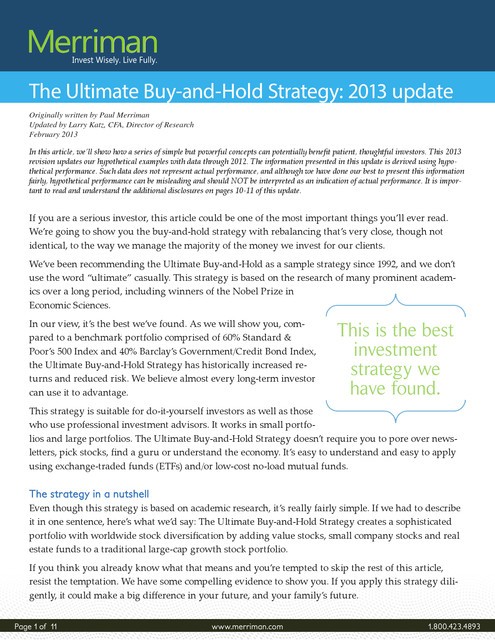The ultimate buyandhold strategy
Post on: 8 Октябрь, 2015 No Comment

PaulA. Merriman
Paul’s Latest Posts
Is this really the “ultimate”?
To qualify for that descriptive term, I believe an investment strategy must have a long track record of outperforming the Standard & Poor’s 500 Index SPX, -0.61% It must do so with no more risk than the index and it must be based on solid academic research.
I’ve been updating this article annually for more than 10 years. Not only do we meet those tests, this is simply the best long-term investment strategy I know.
This strategy works in portfolios big and small, doesn’t rely on predictions or require a guru or special knowledge of the markets or economy. And you can implement it using low-cost index funds and exchange-traded funds.
In a nutshell, 60% of the “Ultimate Buy-and-Hold Strategy” is a sophisticated equity portfolio with worldwide diversification including value stocks, small-company stocks and real-estate funds added to a traditional large-cap growth stock portfolio. The rest of the strategy is made up of short- to intermediate-term government bonds.
This strategy is based on the academic conclusion that in the long run, by far the biggest contributor to investment success (or lack of it) is your choice of asset classes. I’ll show you, in six easy steps, how to use the best-performing asset classes.
Step One: Start with the basics
Imagine a pie, representing all the money you have invested. Below you can see it represented in a chart showing only two slices, one for stocks (Standard & Poor’s 500 Index) and one for bonds (Barclay’s Government Credit Index).
The 60/40 split between stocks and bonds is the way pension funds, insurance companies and other large institutional investors have traditionally allocated their assets. The stocks provide long-term growth while the bonds provide stability and income.
Although this 60/40 mix isn’t perfect for everybody, it’s an industry standard that we’ll use throughout this article as a benchmark.
For 43 years, from January 1970 through December 2012, this portfolio would have produced a compound annual return of 8.5%. That’s not bad, especially considering this period included four of the most severe bear markets of the past 100 years.
Our overriding goals are to build a portfolio that exceeds that return while subjecting investors to no additional risk, which we will measure using standard deviation. Achieving historic returns above 8.5% and a standard deviation of no more than 11.6% is a tall order. This simple benchmark sets a pretty high standard.
In the chart, you’ll see that, allocated this way, an initial investment of $100,000 in 1970 grew to nearly $3.3 million by the end of 2012. As we put this strategy together piece by piece, I will continue to update that number.
Most of the Ultimate Buy and Hold Strategy is concerned with the 60% stock side of the pie, and that’s the main focus of this article. However, it’s very important to get the bond part of this strategy right.
We’ll look at that next.














